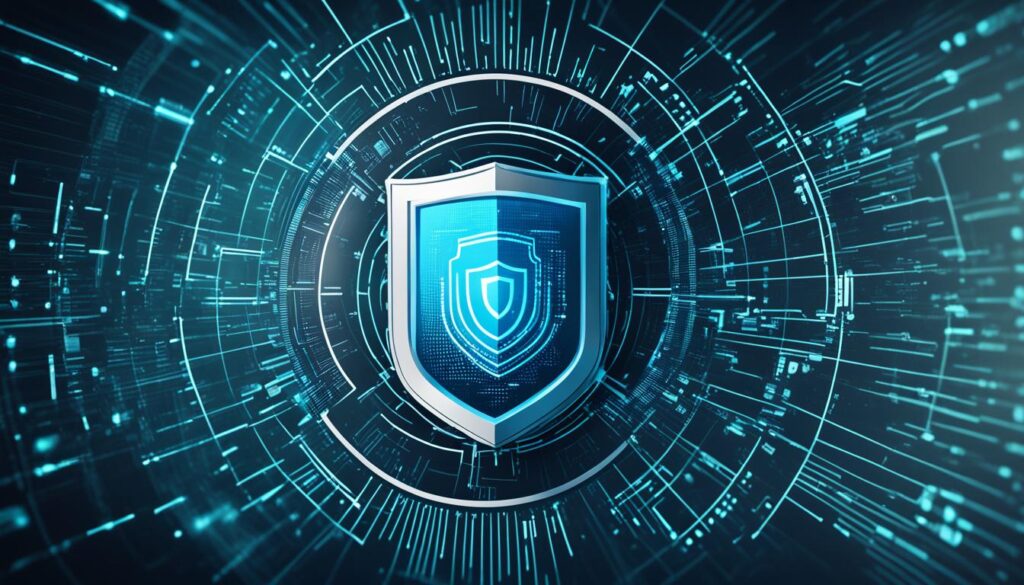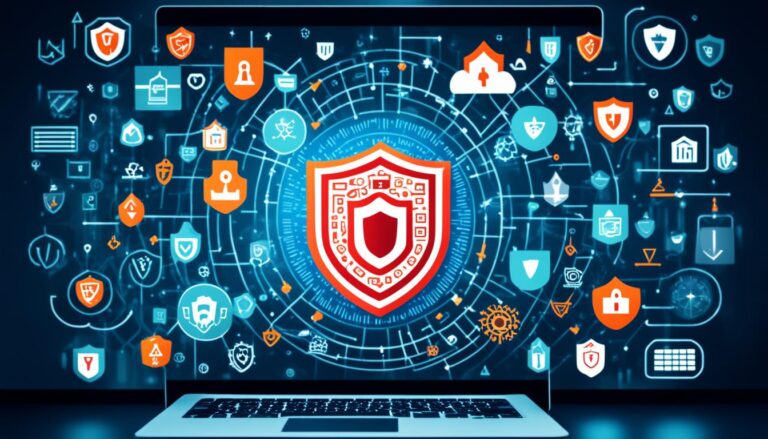Cyber threats are a major risk for companies, not just a small worry. In the last year, more than 50% of small and medium-sized businesses have faced a cyber attack. This highlights how crucial it is for companies to guard their valuable information.
The digital world makes all businesses, regardless of their size, potential targets. Threats like data breaches, ransomware, and phishing can cause severe harm. They might lead to financial ruins, reputation loss, and the business closing down. It’s a matter of when, not if, your business will face this.
But, there are ways to fight back. By applying strong security practices and teaching your team about cyber dangers, you can better protect your company. In this piece, we will dive into the essential actions to keep your business safe from cyber threats and ensure its success.
Key Takeaways:
- Over 50% of small and medium-sized enterprises have experienced a cyber attack in the past year.
- Cyber threats pose a significant risk and can have devastating consequences for businesses.
- Taking proactive measures, such as implementing security strategies and educating employees, is crucial for protecting your business.
- By strengthening your defenses against cyber threats, you can safeguard your business from financial loss and reputational damage.
- Protecting your business from cyber threats should be a top priority in today’s digital landscape.
Secure Your Networks and Data
Protecting your business from cyber threats starts with network security and data encryption. These measures keep confidential data safe from unauthorized eyes. They also help preserve your company’s hard-earned reputation.
Ensure your networks are secure with strong firewalls and the latest intrusion detection systems. Use secure Wi-Fi protocols to keep your data safe. It’s crucial to update your security software frequently to stay ahead of threats.
Adding encryption to your data gives it an extra layer of security. This process turns your important information into an unreadable code. Even if hackers access your data, they won’t be able to use it.
When it comes to storing data, less is often more secure. Keep only essential information in your databases to reduce your risk. This step can significantly lower the impact of a breach.
Prepare for the worst with automatic data backup. Losing data in a cyber attack can be devastating. Backing up your information regularly ensures a safe copy is always available. This way, you can continue operations with minimal disruption.
Stay ahead of cyber threats by adopting these strategies. By securing your networks and protecting your data, you safeguard your business’s future. This also maintains the trust your clients and partners have in your organization.
Network Security Best Practices
- Employ strong firewalls and intrusion detection systems
- Use secure Wi-Fi protocols and encryption
- Regularly update security software and patches
- Be selective about the information stored in company databases
- Set up automatic data backup for critical data
Educate Your Employees about Cybersecurity
Securing your business against cyber threats relies heavily on educating your staff. They need to understand and follow cybersecurity practices and policies. Thorough training empowers them to protect sensitive data and strengthen the company against attacks.
The Role of Employees in Securing Information
Employees serve as the first line of defense against cyber threats. Their actions influence the company’s overall cybersecurity. It’s essential they know their role in keeping information safe.
This involves staying alert for risks, using established practices, and reporting anything suspicious. Their vigilance is key to safeguarding the organization.
Implementing Cybersecurity Practices
Comprehensive training is vital for ensuring employees adhere to cybersecurity practices. They should learn about creating strong passwords and updating them regularly. Sessions should also cover spotting phishing emails, using devices safely, and properly disposing of sensitive data.
The training will prepare employees to recognize and tackle security threats effectively.
Establishing Cybersecurity Policies
Clear, defined cybersecurity policies are just as important as training. These policies lay out how employees should protect sensitive information. They also outline procedures and guidelines for dealing with security incidents.
Here’s an example table highlighting essential cybersecurity policy components:
| Policies and Guidelines | Description |
|---|---|
| Acceptable Use Policy | Defines the proper use of company resources, including email and internet. |
| Password Policy | Outlines requirements for password strength and rules against sharing. |
| Data Classification Policy | Details how different data types should be handled and stored securely. |
| Incident Response Policy | Explains the steps to take when a cybersecurity incident occurs. |
Having strong policies and educating staff fosters a culture of security in your organization. This approach makes your defenses more robust. It decreases the chance of successful cyber attacks. Keep in mind, everyone in the company plays a part in cybersecurity, requiring ongoing education and staying alert.
Establish Cybersecurity Practices and Policies
Developing robust cybersecurity practices and comprehensive policies is key for businesses today. In this digital era, they protect against cyber threats and offer a roadmap for handling security issues. By outlining clear steps and best practices, companies bolster their defenses. This protects their important assets.
Key Elements of Cybersecurity Practices and Policies
Cybersecurity practices and policies rely on essential elements. These work together to ensure a secure business environment. The critical parts include:
- Regular Risk Assessments: Businesses can find vulnerabilities and prioritize security efforts through regular assessments. They can spot weak security areas and reinforce their defenses.
- Employee Training: Employee education on cybersecurity roles is vital. Companies boost their security by offering in-depth training. This equips staff with the skills to spot and deal with threats.
- Secure Password Policies: A strong password policy is a must to safeguard sensitive data. Businesses should encourage complex passwords, updates, and two-factor verification. This minimizes the risk of unwarranted data access.
- Network Security Measures: Robust network security is achieved with firewalls, intrusion detection, and encryption. Keeping security measures up to date and monitoring network activity spots and fixes security issues.
Resolving Security Issues
Even with proactive steps, security problems can emerge. It’s vital to have a plan for swift and effective resolution. When security incidents occur, being prepared to act promptly is crucial for recovery and impact reduction.
Detecting a security issue means isolating it, investigating thoroughly, and applying necessary updates fast. It’s equally important to inform all stakeholders, ensuring transparency and trust. This fosters a collaborative approach to issue resolution.
Control Physical Access to Devices
Securing digital networks is paramount, yet restricting physical device access is also critical. Unauthorized entry can trigger data breaches and security infringements. Thus, it is essential to practice stringent access control to combat these threats.
Proper Disposal of Devices
Disposing of outdated devices properly is key to eradicating potential data threats. Haphazard disposal of laptops, tablets, and smartphones can leak secure data to the wrong hands. Hence, businesses must adopt safe disposal methods:
- Perform a factory reset to wipe all data from the device.
- Physically destroy storage media, such as hard drives, to ensure data cannot be recovered.
- Consider engaging professional electronic waste recycling services that adhere to appropriate data destruction protocols.
Following these protocols allows enterprises to thwart unauthorized data access and observe data protection laws.
Securing Portable Devices
Portable devices like laptops and tablets stand out as prime targets for theft or unapproved access. Hence, applying protective measures is vital:
- Use strong passwords or passcodes to secure device access.
- Enable encryption to protect data stored on the device.
- Install remote tracking and data-wiping capabilities to mitigate potential security breaches.
Moreover, employee awareness about the need for device security is crucial. Workers must understand the significance of locking devices and immediately reporting losses or thefts. This ensures portable device integrity.
By deploying measures to control physical access to devices, businesses ward off cyber theft. Proper device disposal and secure handling of portable gadgets are key steps in this security vigilance. These actions safeguard against unauthorized entry and avert potential data risks.

| Key Steps to Control Physical Access to Devices | Benefits |
|---|---|
| Proper disposal of outdated devices | – Mitigates the risk of data breaches – Ensures compliance with data protection regulations |
| Securing portable devices | – Prevents unauthorized access – Reduces the risk of theft – Safeguards sensitive information |
Train Employees to Recognize and Report Cyber Threats
Training staff to spot and report cyber threats is key for any business. With detailed training, companies empower their teams to notice and act on potential cyber attacks. This proactive strategy helps avoid attacks and boosts security.
It’s crucial to teach employees about various cyber threats they might face, like false antivirus alerts or strange emails. Such training makes workers more alert, reducing the chance of cyber attacks.
Next, organizations must have clear steps for reporting any suspicions. This ensures timely and effective threat reporting. Cultivating a reporting culture not only improves security but also team spirit and responsibility.
Employees should be encouraged to report any odd occurrences, even if it’s a false alarm. This “better safe than sorry” culture fosters swift handling of potential threats. It helps ensure a serious approach to the company’s cyber defense.
Benefits of Employee Training
- Increased awareness and understanding of cyber threats
- Improved ability to identify and respond to potential attacks
- Enhanced overall cybersecurity within the organization
- Development of a vigilant culture
- Lower risk of data breaches and financial harm
Comprehensive training is an investment in your company’s security. It turns employees into a strong defense against cyber threats. Recognizing their impact is a cornerstone of effective security strategies and information protection.
Teaching employees to see and report cyber threats is vital. They become part of the company’s security measures, significantly decreasing attack risks. In the fight against cybercrime, every worker’s alertness is crucial.
Communicate with Customers about Security Measures
In today’s digital age, building trust is crucial for businesses. Proactively talking to customers about the security of their personal information is an effective step. By doing so, businesses show they care and are serious about data protection.
Businesses should highlight secure communication methods to customers. Using encrypted channels for sensitive data transmission is key. This practice protects information from threats. It’s important to make customers aware that their safety is top priority. Their personal data won’t be requested through insecure channels like email or instant messaging.
Encouraging customers to stay alert and report sketchy messages is also vital. Their quick reports can stop or flag potential security issues. This partnership helps businesses act swiftly and maintain their data protection measures.
Example Table: Secure Communication Methods
| Secure Communication Method | Description |
|---|---|
| Secure Online Forms | Utilize secure web forms that encrypt and protect customer data during transmission. |
| Encrypted Messaging Apps | Recommend the use of encrypted messaging apps for secure communication and file sharing. |
| Protected Customer Portals | Provide customers with access to password-protected portals for secure information exchange. |
Transparent and open communication strengthens business-customer ties. It showcases a firm’s dedication to data safety. Prioritizing secure methods of communication ensures a safe digital journey for customers. This approach not only builds trust but also customer loyalty.
Follow Best Practices for Online Security
Protecting your business from online risks demands the application of top security methods. These steps boost your protection, lowering the chance of cyber attacks.
Keep Security Software Up to Date
It’s essential to keep your security software updated to combat new cyber threats. Updates often fix security gaps and enhance protection. Use auto-updates to guarantee your software is always top-notch.
Use Strong Passwords
Strong passwords are your first barrier against unauthorized entry to your data. Craft unique, robust passwords for each account. This means combining various characters and using a password manager for extra security.
Be Cautious When Downloading Files or Clicking on Links
Exercise care with downloads and links to prevent malware. Only download from reliable sources and steer clear of suspicious emails and sites. Ensure your team understands the dangers of unverified downloads and links to keep them safe.
Educate Employees on Malware Prevention
Employee education is key to keeping your cyber space safe. Offer thorough malware prevention training, including safe browsing habits. Prompt them to report any odd activity they notice to your IT or security team.
Implement Multifactor Authentication
Multifactor authentication enhances your system’s defense by adding an extra confirmation step. Even if a password is breached, this extra layer minimizes unauthorized access.
Regularly Back up Your Data
Backing up your data is critical for recovery in case of an attack or data loss. Ensure your data is backed up both onsite and offsite. Include vital customer and financial data. This practice helps minimize damage and speeds up recovery.

By adhering to these online security best practices, you create a solid defense against cyber threats. Keep your software current, use strong passwords, watch out for suspect downloads and links, educate your team, employ multifactor authentication, and back up your data. These steps significantly improve your security readiness and dampen the risk of cyber assaults.
Secure Your Wi-Fi Networks
Protecting your business from cyber threats starts with your Wi-Fi networks. Weak or open networks might expose your data to hackers and potential breaches.
Encrypting your Wi-Fi is key to its security. This means turning your network data into a code that only trusted parties can read. By doing this, intercepting and understanding your data becomes exceedingly hard for cybercriminals.
Alongside encryption, strong passwords are a must. Opt for a password that’s both intricate and unique. Include a mix of letters, numbers, and symbols. Steer clear of simple or common passwords, such as ‘password’ or ‘123456’. Keep your password fresh by updating it regularly.
Hiding your network’s SSID can further bolster its defenses. When your network name is not visible, it’s harder for would-be attackers to pinpoint it. This strategy adds an additional shield, making it tough for outsiders to even find your network.
Employing encryption, robust passwords, and a hidden SSID vastly drops the chances of unwelcome guests on your network. These steps are critical in protecting your business’s most sensitive data from cyber threats.
Tips for Securing Wi-Fi Networks
| Security Measure | Description |
|---|---|
| Encrypt Wi-Fi Networks | Encode the transmitted data, making it unreadable to unauthorized individuals |
| Use Strong Passwords | Create unique and complex passwords to prevent unauthorized access |
| Hide the SSID | Make the network name less visible to deter potential attackers |
| Regularly Update Passwords | Change Wi-Fi network passwords on a regular basis to maintain security |
Backup Your Data Regularly
Backing up your data ensures your business is safe from cyber attacks. It protects critical information, including documents and financial files. With backup copies, recovery after data loss is quick, limiting potential harm.
Using automatic backup methods is both reliable and effective. This approach eliminates the chance of errors or missed backups. Thus, you can direct your attention to business operations, confident in your data’s constant protection.
Consider offsite or cloud-based storage for backups. Offsite storage keeps physical copies of data in a secure location away from the main site. This strategy safeguards data against physical disasters, like fires or floods.
Alternatively, cloud storage provides secure internet data storage. It encrypts and duplicates data across multiple centers, ensuring its safety and accessibility worldwide. Cloud storage is an attractive option for its convenience and reliability.
The Benefits of Regular Data Backup:
- Protection against data loss from cyber attacks
- Quick recovery of critical information
- Minimization of potential downtime and disruption
- Peace of mind knowing your data is securely backed up
Develop a regular data backup plan and select the best storage option for your business. This will protect crucial data and ensure your business can survive through any cyber threat. Start your data backup strategy today, it’s crucial not to delay.
Conclusion
In our technology-driven world, safeguarding your business against cyber threats is paramount. These threats endanger the safety and confidentiality of critical data. Yet, through robust cybersecurity measures, organizations can fortify their defenses against cyber attacks.
One key defense is securing both networks and devices. This involves encrypting valuable data and limiting physical access. Such steps reduce the chances of data breaches and unauthorized entry, thus protecting company information.
Equally crucial is educating staff on cybersecurity norms and guidelines. Teaching employees to identify and respond to digital threats fosters an atmosphere of vigilance. This ensures that the entire workforce is an active participant in upholding the company’s digital security.
In the end, a firm’s commitment to cyber protection is vital. By embedding cybersecurity into their operations and emphasizing the safety of digital assets, businesses can shield themselves effectively. They guard against cyber intrusions and maintain the integrity of their data.



